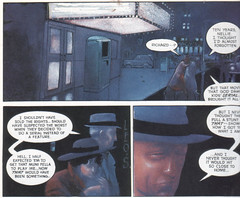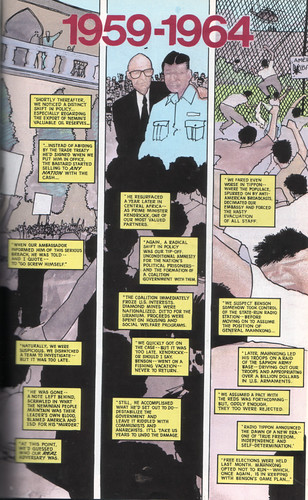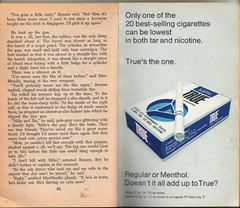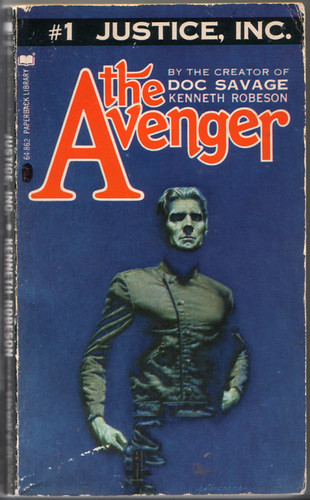
Oh, and appreciate it I did.
If you were of junior-high or high-school age in the late sixties or early seventies and possessed of a certain set of interests and tastes - those which might also lead to reading comics - you almost certainly read the Bantam Doc Savage paperbacks, with the fantastic James Bama covers, which reprinted the pulp stories from the thirties. My friends and I devoured them - I can remember turning over my 75 cents at Lowen's drug store one day after school, taking one of Doc's adventures home, reading the whole thing, and then returning to splurge on another before the store closed for the night.
If you were really lucky, not only could you find and enjoy Kenneth Robeson's best-known hero, you could also find his strongest second-stringer, Richard Benson, The Avenger. His adventures were published by Coronet under the Paperback Library imprint, and the cover formats and art were clearly imitations of the Bantam series. While Kenneth Robeson did not in fact exist except as a house name used by Street & Smith, the publisher of the original pulps (most of the Doc Savage stories were written by Lester Dent and those of the Avenger by Paul Ernst), the same rough exuberance and page-turning (though formulaic) plotting could be found in both series, so the packaging similarities were not misleading
In some ways, Doc and the Avenger could be looked at as embodying the same opposing aspects of "heroing" as Superman and Batman (or Achilles and Odysseus) do.
Doc was all glittery and bold, not only a man at the pinnacle of human abilities, but also a public figure, a celebrity who had pull with politicians, someone dedicated to doing good because he was a good man. Benson's impetus was darker: his mission for justice started as a personal quest to find who murdered his wife and child. His methods were darker; chief among them was impersonation, a skill gained when the shock from the loss of his family deadened his face, making it pliable. He worked in secret, not headquartered at the top of a skyscraper, but hidden behind a drugstore.
Doc Savage had skin and hair of bronze and gold flake eyes; Richard Benson had white hair, snowy features and steel-grey eyes. Gold and silver, marked down for the pulps.
I think I dug the Avenger even more than I did Doc. Maybe because his smaller stature - five-eight compared to Doc's six-six - and his mantra of "there's quality of muscle as well as quantity" made him more identifiable to me than Doc. Maybe it was the minimalism of Mike and Ike, his matched throwing knife and .22 caliber pistol. Maybe it was because his gang of sidekicks was integrated; he had a married African-America couple on his team, compared to Doc's all-male, all-WASP Fab Five. Or maybe it was because his adventures had a more urban feel to them.
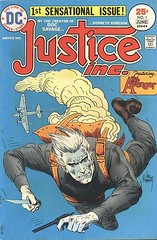 DC Comics tired to capture the Avenger's appeal in comics twice. The first attempt was in 1975, not long after the first paperback appeared. While none of the four issues published remain the The Last Shortbox, I had them all, and remember them most for Joe Kubert's stunning covers and Jack Kirby's muscular interior art. The stories, however, seem to miss the spirit of the original series, and the comics aren't worth seeking out. If you trip across any, though, give 'em a look.
DC Comics tired to capture the Avenger's appeal in comics twice. The first attempt was in 1975, not long after the first paperback appeared. While none of the four issues published remain the The Last Shortbox, I had them all, and remember them most for Joe Kubert's stunning covers and Jack Kirby's muscular interior art. The stories, however, seem to miss the spirit of the original series, and the comics aren't worth seeking out. If you trip across any, though, give 'em a look.The second adaptation DC made was in a two-part graphic novel (or were we calling them prestige format comics then?) in 1989, which I still own. This one gets a bit meta: Andy Helfer's story (moodily illustrated by Kyle Baker) essentially turns the entire pulp canon into the retelling of Benson's life story by the entertainment media:
Although the impersonation motif is still present and central to the story, all the pulpish trappings are gone and any vestiges swept away as Benson gets drawn into a byzantine Cold War espionage plot that unfolds over more than two decades and reveals J. Edgar Hoover (sort of) to be the antichrist (sort of) and Benson himself to behind the increasing democratization of the world. No, really.
The book makes wonderful use of fantastical and science-fiction elements to make some compelling points about geopolitical realities in the last half of the twentieth century and is well worth a read. It's just not the Avenger. So, I'll keep watching for another comics adaptation that more closely captures the magic I first felt when I encountered that paperback more than thirty years ago.
Notes:
A big shout out to Robert Lenihan, whom I haven't seen in twenty years and who first handed me a copy of the paperback shown above.
Here's a scan of the interior of the book, complete with the cardstock cigarette ad that was bound into it. Time have sure changed, no?
